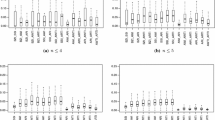Abstract
In the general case, complexity of the algorithm to calculate the power indices grows exponentially with the number of voting agents. Yet the volume of calculations may be reduced dramatically if many coalitions have equal numbers of votes. The well-known algorithm for calculation of the Banzhaf and Shapley-Shubik indices was generalized, which enables fast calculation of the power indices where entry of the voting agent into a coalition depends on its preferences over the set of the rest of agents.
Similar content being viewed by others
References
Felsenthal, D.S. and Machover, M., The Measurement of Voting Power, Cheltenham: Edward Elgar, 1998.
Aleskerov, F., Power Indices Taking into Account Agents’ Preferences, in Mathematics and Democracy, Berlin: Springer, 2006, pp. 1–18.
Bilbao, J.M., Fernandez, J.R., Jimenes, A., and Lopez, J.J., Generating Functions for Computing Power Indices Efficiently, Top, 2000, vol. 8(2), pp. 191–213.
Yakuba, V., Evaluation of Banzhaf Index with Restrictions on Coalitions Formation, Math. Comput. Mod., 2008, vol. 48, pp. 1602–1610.
Banzhaf, J.F., Weighted Voting Doesn’t Work: A Mathematical Analysis, Rutgers Law Review, 1965, vol. 19, pp. 317–343.
Shapley, L.S. and Shubik, M., A Method for Evaluating the Distribution of Power in a Committee System, Am. Polit. Sci. Rev., 1954, vol. 48(3), pp. 787–792.
Johnston, R.J., On the Measurement of Power: Some Reactions to Laver, Environ. Planning, 1978, vol. 10, pp. 907–914.
Deegan, J. and Packel, E.W., A New Index of Power for Simple n-Person Games, Int. J. Game Theory, 1978, vol. 7(2), pp. 113–123.
Holler, M.J. and Packel, E.W., Power, Luck and the Right Index, J. Econom., 1983, vol. 43, pp. 21–29.
Leech, D., Computation of Power Indices, in Warwick Economic Research Papers, Coventry: Univ. of Warwick, 2002, no. 644.
Aleskerov, F.T., Blagoveshchenskii, N.Yu., Satarov, G.A., et al., Vliyanie i strukturnaya ustoichivost’ v Rossiiskom parlamente (1905–1917 and 1993–2005 gg.) (Influence and Structural Stability in the Russian Parliament (1905–1917 and 1993–2005)), Moscow: Fizmatlit, 2007.
Author information
Authors and Affiliations
Additional information
Original Russian Text © D.A. Shvarts, 2009, published in Avtomatika i Telemekhanika, 2009, No. 3, pp. 152–159.
Rights and permissions
About this article
Cite this article
Shvarts, D.A. On calculation of the power indices with allowance for the agent preferences. Autom Remote Control 70, 484–490 (2009). https://doi.org/10.1134/S0005117909030138
Received:
Published:
Issue Date:
DOI: https://doi.org/10.1134/S0005117909030138



